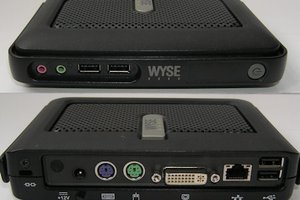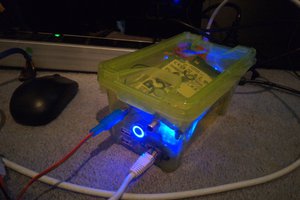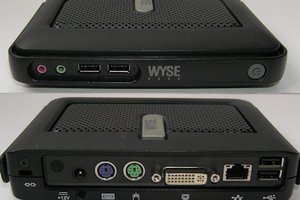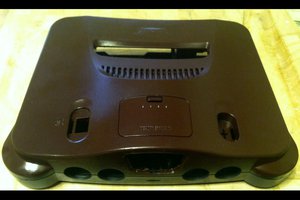IVAR, the hack rack
Since I've got a lot of my stuff in an IKEA IVAR rack, I decided to take the rack to the next level.
Since I've got a lot of my stuff in an IKEA IVAR rack, I decided to take the rack to the next level.
To make the experience fit your profile, pick a username and tell us what interests you.
We found and based on your interests.
DS1504Z_bracket_front.stlstl-binary - 132.90 kB - 01/02/2020 at 08:37 |
|
|
PeakTech-6227_bracket.stlstl-binary - 80.18 kB - 01/02/2020 at 08:37 |
|
|
DS1504Z_bracket_back.stlstl-binary - 69.53 kB - 01/02/2020 at 08:37 |
|
|
PeakTech-6227_bracket.scadx-openscad - 481.00 bytes - 01/02/2020 at 08:37 |
|
|
DS1504Z_bracket_front.scadx-openscad - 526.00 bytes - 01/02/2020 at 08:37 |
|
It was time to buy a function generator, and of course it had to go into the rack:
The power tools at the bottom had to move to a different place, but I didn't really need them on the rack so that's probably fine.
Now that I have two SCPI capable devices on the rack, it's probably time for a little network switch...
I usually build breadboard circuits on IVAR's top shelf. They almost always require some sort of power supply cable, USB, scope probes and other stuff hanging from the sides and quite often things get pulled out by the weight of a cable. I needed to come up with some sort of cable management, and I wanted something that is easy to obtain, install and use.
A quick tech screen (= ask in hack chat and get tons of silly ideas back) revealed plastic binders. They're cheap, can be bought in any office supply store, and can be cut to the desired length and stapled to the rack:
What you seen in the image is a ring binder with 16 mm diameter, and it's almost a bit too loose - but it works very well. 14 feels a bit better, and 12 mm is too small to be useful. The edges of those circular "flaps" are quite sharp and slightly "bite" into the cable for more grip. That might sound a bit dangerous but no cable has been damaged so far.
The ATX PSU I had installed previously was moved to my 3D printer, so I needed a new PSU for IVAR. I looked for a small one that wouldn't occupy too much space and luck was on my side - it fits next to the scope:
The PSU is a PeakTech 6227, 0-60 V, 0-6 A.
I printed a bracket to keep it from being push back when I plug in cables:
I only printed one of these to go behind the PSU's back feet since the front can't move sideways anyway.
OpenSCAD and STL files for the brackets (DS1054Z, PeakTech 6227) are in the project files section.
In general, this is what I have in my hack rack (from top to bottom):
There's still room for another small box (currently there's a cutting mat in that space) and I'm not sure what exactly to put there. Maybe finer tools that I don't want to be thrown around like the more robust stuff.
Made 3d printed mounting brackets for the scope. They fit quite nicely:
They were easy to design, print and install and the scope doesn't move at all any more. Just what I needed.
New in the top floor:
PSU is not really connected yet (apart from mains). Here's the multi socket:
It has 3 outlets, two if which are used for the RPI's and USB hub's wall warts. The hub is installed towards the side because that was simply the easiest thing to do without having it stick out from the front. Yes, the picture quality sucks, but it does the job:
I found a piece of scrap wood that neatly fits between into the narrow vertical side space. Installed it with a hinge and added an RPi:
The RPi will be in my local WiFi and grant me access to the scope's LAN connection. It will probably be "closed" during normal usage, but I can open the RPi flap and add stuff for testing if I desire to do so.
The scope mount is probably too simple, but it does the job quite well. Two pieces of a cable channel with a cutout, screwed to the front, for the scope to "slide" in, and a piece of pipe to keep it from sliding to the back:
Here's a picture with the scope, from behind:
The individual IVAR shelves are held in place by four pins that go into holes spaced by about 32 mm. That's one IVAR height unit (HU). A few examples that fit quite nicely:
The holes also make it easy to build hinges for temporary side-racks. I have some ideas for that.
I removed a lot of the stuff that was in there and rearranged the shelves a bit:
From top to bottom:
The X-shaped thing in the background is supposed to make the rack stay upright, but it's also blocking access from the rear. However I think I'll want to be able to access the rack from two sides. It will have to go and be replaced with something else.
At the bottom I Installed a base plate (MDF) and four castors. They don't turn freely though and sometimes get stuck on a mounting screw's head. I might change them for larger ones (will never happen I guess), but this will do for now:
I want to mount my Rigol DS1054Z scope to the rack. That alone won't be too hard, but there are two complications:
So I decided to add a Raspberry Pi (3B+) to the scope, to give it a wifi interface. That, however, wasn't the easiest thing for me because my networking experience ends at "install pre-configured router, get cat pictures". The devices involved are:
Primary goal: get screenshots from the scope to my laptop over wifi.
After some discussion about the right approach in the hack chat and on stack exchange (https://unix.stackexchange.com/questions/489232/connect-lan-device-to-wlan-using-a-raspberry-pi), I've finally found a working solution (thanks to @Ted Yapo ).
interface eth0 static ip_address=192.168.220.1/24 static routers=192.168.178.1
#net.ipv4.ip_forward=1
sudo sh -c "echo 1 > /proc/sys/net/ipv4/ip_forward"
Configure static IP in the new subnet:
Add a routing rule to the new subnet via the RPi's wifi interface
Preparation of the laptop:
Nothing network specific, I just installed the ds1054z python package. See https://hackaday.io/project/7691-ds1054z-python-package and https://pypi.org/project/ds1054z/.
Now iIt's easy: open a terminal on the laptop and execute
ds1054z save-screen --overlay 0.6 192.168.220.2
In my network this takes about 4 seconds. The result is placed in the current working directory and would look like this:
The screenshot with my scope's IP configuration was taken with the same method, so you get menus as well - whatever you see on the real screen.
So one more device to add to the rack.
Create an account to leave a comment. Already have an account? Log In.
The little tabs do break quickly, though. But that's not really a problem because I was looking for something quick and dirty rather than robust - and they're cheap and very easy to replace!
Become a member to follow this project and never miss any updates

 matthewkleinmann
matthewkleinmann


 Retroplayer
Retroplayer
love the cable manager, very nice.